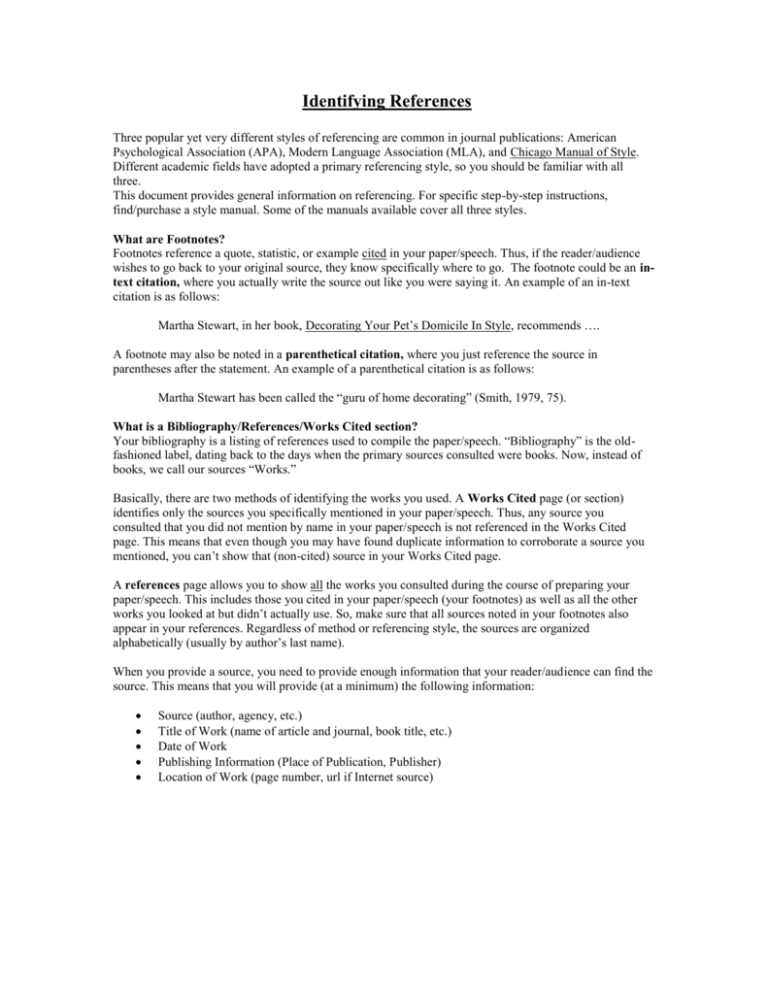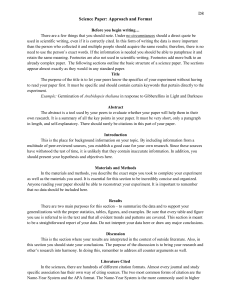Identifying References
advertisement

Identifying References Three popular yet very different styles of referencing are common in journal publications: American Psychological Association (APA), Modern Language Association (MLA), and Chicago Manual of Style. Different academic fields have adopted a primary referencing style, so you should be familiar with all three. This document provides general information on referencing. For specific step-by-step instructions, find/purchase a style manual. Some of the manuals available cover all three styles. What are Footnotes? Footnotes reference a quote, statistic, or example cited in your paper/speech. Thus, if the reader/audience wishes to go back to your original source, they know specifically where to go. The footnote could be an intext citation, where you actually write the source out like you were saying it. An example of an in-text citation is as follows: Martha Stewart, in her book, Decorating Your Pet’s Domicile In Style, recommends …. A footnote may also be noted in a parenthetical citation, where you just reference the source in parentheses after the statement. An example of a parenthetical citation is as follows: Martha Stewart has been called the “guru of home decorating” (Smith, 1979, 75). What is a Bibliography/References/Works Cited section? Your bibliography is a listing of references used to compile the paper/speech. “Bibliography” is the oldfashioned label, dating back to the days when the primary sources consulted were books. Now, instead of books, we call our sources “Works.” Basically, there are two methods of identifying the works you used. A Works Cited page (or section) identifies only the sources you specifically mentioned in your paper/speech. Thus, any source you consulted that you did not mention by name in your paper/speech is not referenced in the Works Cited page. This means that even though you may have found duplicate information to corroborate a source you mentioned, you can’t show that (non-cited) source in your Works Cited page. A references page allows you to show all the works you consulted during the course of preparing your paper/speech. This includes those you cited in your paper/speech (your footnotes) as well as all the other works you looked at but didn’t actually use. So, make sure that all sources noted in your footnotes also appear in your references. Regardless of method or referencing style, the sources are organized alphabetically (usually by author’s last name). When you provide a source, you need to provide enough information that your reader/audience can find the source. This means that you will provide (at a minimum) the following information: Source (author, agency, etc.) Title of Work (name of article and journal, book title, etc.) Date of Work Publishing Information (Place of Publication, Publisher) Location of Work (page number, url if Internet source) Examples of APA for a Reference Page All of the information below was taken from http://owl.english.purdue.edu/handouts/research/r_apa.html#Examples The Publication Manual of the American Psychological Association provides extensive examples covering a wide variety of potential sources. Below are examples for some of the most commonly cited kinds of sources. If your particular source is not listed below, use the web address above to determine the correct format, check the Publication Manual, or consult the APA style website, especially their Frequently Asked Questions about APA Style and their coverage of electronic references. Our additional resources section also has some links to examples and resources. Journal article, one author Harlow, H. F. (1983). Fundamentals for preparing psychology journal articles. Journal of Comparative and Physiological Psychology, 55, 893-896. Journal article, three to six authors Kernis, M. H., Cornell, D. P., Sun, C. R., Berry, A., & Harlow, T. (1993). There's more to self-esteem than whether it is high or low: The importance of stability of self-esteem. Journal of Personality and Social Psychology, 65, 1190-1204. Journal article, more than six authors Harris, M., Karper, E., Stacks, G., Hoffman, D., DeNiro, R., Cruz, P., et al. (2001). Writing labs and the Hollywood connection. Journal of Film and Writing, 44(3), 213-245. NOTE: The phrase et al. stands for "and others." Work discussed in a secondary source Coltheart, M., Curtis, B., Atkins, P., & Haller, M. (1993). Models of reading aloud: Dual-route and parallel-distributed-processing approaches. Psychological Review, 100, 589-608. NOTE: Give the secondary source in the references list; in the text, name the original work, and give a citation for the secondary source. For example, if Seidenberg and McClelland's work is cited in Coltheart et al. and you did not read the original work, list the Coltheart et al. reference in the References. In the text, use the following citation: In Seidenberg and McClelland's study (as cited in Coltheart, Curtis, Atkins, & Haller, 1993), ... Magazine article, one author Henry, W. A., III. (1990, April 9). Making the grade in today's schools. Time, 135, 28-31. Book Calfee, R. C., & Valencia, R. R. (1991). APA guide to preparing manuscripts for journal publication. Washington, DC: American Psychological Association. An article or chapter of a book O'Neil, J. M., & Egan, J. (1992). Men's and women's gender role journeys: Metaphor for healing, transition, and transformation. In B. R. Wainrib (Ed.), Gender issues across the life cycle (pp. 107-123). New York: Springer. A government publication National Institute of Mental Health. (1990). Clinical training in serious mental illness (DHHS Publication No. ADM 90-1679). Washington, DC: U.S. Government Printing Office. A brochure Research and Training Center on Independent Living. (1993). Guidelines for reporting and writing about people with disabilities (4th ed.) [Brochure]. Lawrence, KS: Author. A book or article with no author or editor named Merriam-Webster's collegiate dictionary (10th ed.).(1993). Springfield, MA: Merriam-Webster. Examples of APA continued A book or article with no author or editor named New drug appears to sharply cut risk of death from heart failure. (1993, July 15). The Washington Post, p. A12. NOTE: For parenthetical citations of sources with no author named, use a shortened version of the title instead of an author's name. Use quotation marks and italics as appropriate. For example, parenthetical citations of the two sources above would appear as follows: (Merriam-Webster's, 1993) and ("New Drug," 1993). A translated work and/or a republished work Laplace, P. S. (1951). A philosophical essay on probabilities (F. W. Truscott & F. L. Emory, Trans.). New York: Dover. (Original work published 1814) NOTE: When you cite this work in text, it should appear with both dates: Laplace (1814/1951). A review of a book, film, television program, etc. Baumeister, R. F. (1993). Exposing the self-knowledge myth [Review of the book The self-knower: A hero under control]. Contemporary Psychology, 38, 466-467. An entry in an encyclopedia Bergmann, P. G. (1993). Relativity. In The new encyclopedia britannica (Vol. 26, pp. 501-508). Chicago: Encyclopedia Britannica. A print journal or newspaper article retrieved from an online database When referencing material obtained from an online database (such as a database in the library), provide appropriate print citation information (formatted just like a "normal" print citation would be for that type of work). Then add information that gives the date of retrieval and the proper name of the database. This will allow people to retrieve the print version if they do not have access to the database from which you retrieved the article. You can also include the item number or accession number in parentheses at the end, but the APA manual says that this is not required. (For more about citing articles retrieved from electronic databases, see page 278 of the Publication Manual.) Smyth, A. M., Parker, A. L.,& Pease, D. L. (2002). A study of enjoyment of peas. Journal of Abnormal Eating, 8(3). Retrieved February 20, 2003, from PsycARTICLES database. An online journal article Kenneth, I. A. (2000). A Buddhist response to the nature of human rights. Journal of Buddhist Ethics, 8(4).Retrieved February 20, 2001, from http://www.cac.psu.edu/jbe/twocont.html Chapter or section of an online document The Foundation for a Better World. (2000). Pollution and banana cream pie. In Great chefs cook with chlorofluorocarbons and carbon monoxide (Chap. 3). Retrieved July 13, 2001, from http://www.bamm.com/cream/pollution/bananas.htm NOTE: Use a chapter or section identifier and provide a URL that links directly to the chapter section, not the home page of the Web site. Message posted to an online newsgroup, forum, or discussion group Frook, B. D. (1999, July 23). New inventions in the cyberworld of toylandia [Msg 25]. Message posted to http://groups.earthlink.com/forum/messages/00025.html NOTE: If only the screen name is available for the author, then use the screen name; however, if the author provides a real name, use their real name instead. Be sure to provide the exact date of the posting. Follow the date with the subject line, the thread of the message (not in italics). Provide any identifiers in brackets after the title, as in other types of references. A Motion Picture or Video Tape with international or national availability Smith, J.D. (Producer), & Smithee, A.F. (Director). (2001). Really Big Disaster Movie [Motion picture]. United States: Paramount Pictures. Examples of APA continued A Motion Picture or Video Tape with limited availability Harris, M. (Producer), & Turley, M. J. (Director). (2002). Writing Labs: A History [Motion picture]. (Available from Purdue University Pictures, 500 Oval Drive, West Lafayette, IN 47907) A Television Broadcast Important, I.M. (Producer). (1990, November 1). The Nightly News Hour. [Television broadcast]. New York: Central Broadcasting Service. A Television Series Bellisario, D.L. (Producer). (1992). Exciting Action Show. [Television series]. Hollywood: American Broadcasting Company. A Single Episode of a Television Series Wendy, S. W. (Writer), & Martian, I.R. (Director). (1986). The rising angel and the falling ape. [Television series episode]. In D. Dude (Producer), Creatures and monsters. Los Angeles: Belarus Studios. A music recording Taupin, B. (1975). Someone saved my life tonight [Recorded by Elton John]. On Captain fantastic and the brown dirt cowboy [CD]. London: Big Pig Music Limited.





